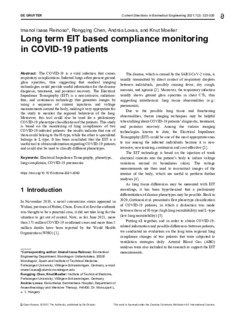| dc.rights.license | Attribution 4.0 International | * |
| dc.contributor.author | Isasa Reinoso, Imanol | |
| dc.contributor.other | Chen, Rongquing | |
| dc.contributor.other | Lovas, Andras | |
| dc.contributor.other | Möeller, Knut | |
| dc.date.accessioned | 2023-03-28T18:29:36Z | |
| dc.date.available | 2023-03-28T18:29:36Z | |
| dc.date.issued | 2021 | |
| dc.identifier.issn | 2364-5504 | en |
| dc.identifier.other | https://katalogoa.mondragon.edu/janium-bin/janium_login_opac.pl?find&ficha_no=167127 | en |
| dc.identifier.uri | https://hdl.handle.net/20.500.11984/6068 | |
| dc.description.abstract | The COVID-19 is a viral infection that causes respiratory complications. Infected lungs often present ground glass opacities, thus suggesting that medical imaging technologies could provide useful information for the disease diagnosis, treatment, and posterior recovery. The Electrical Impedance Tomography (EIT) is a non-invasive, radiationfree, and continuous technology that generates images by using a sequence of current injections and voltage measurements around the body, making it very appropriate for the study to monitor the regional behaviour of the lung. Moreover, this tool could also be used for a preliminary COVID-19 phenotype classification of the patients. This study is based on the monitoring of lung compliances of two COVID-19-infected patients: the results indicate that one of them could belong to the H-type, while the other is speculated belongs to L-type. It has been concluded that the EIT is a useful tool to obtain information regarding COVID-19 patients and could also be used to classify different phenotypes. | en |
| dc.language.iso | eng | en |
| dc.publisher | De Gruyter | en |
| dc.rights | © 2021 The Authors | en |
| dc.rights.uri | http://creativecommons.org/licenses/by/4.0/ | * |
| dc.subject | Electrical Impedance Tomography | en |
| dc.subject | phenotype | en |
| dc.subject | lung compliance | en |
| dc.subject | COVID-19 pneumonia | en |
| dc.title | Long term EIT based compliance monitoring in COVID-19 patients | en |
| dc.type | http://purl.org/coar/resource_type/c_6501 | |
| dcterms.accessRights | http://purl.org/coar/access_right/c_abf2 | en |
| dcterms.source | Current Directions in Biomedical Engineering | en |
| local.description.peerreviewed | true | en |
| local.description.publicationfirstpage | 323 | en |
| local.description.publicationlastpage | 326 | en |
| local.identifier.doi | https://doi.org/10.1515/cdbme-2021-2082 | en |
| local.rights.publicationfee | APC | en |
| local.rights.publicationfeeamount | 1000 EUR | en |
| local.contributor.otherinstitution | https://ror.org/02m11x738 | en |
| local.contributor.otherinstitution | Kiskunhalas Semmelweis Hospital | en |
| local.source.details | Vol. 7. N. 2. | en |
| oaire.format.mimetype | application/pdf | en |
| oaire.file | $DSPACE\assetstore | en |
| oaire.resourceType | http://purl.org/coar/resource_type/c_6501 | en |
| oaire.version | http://purl.org/coar/version/c_970fb48d4fbd8a85 | en |








